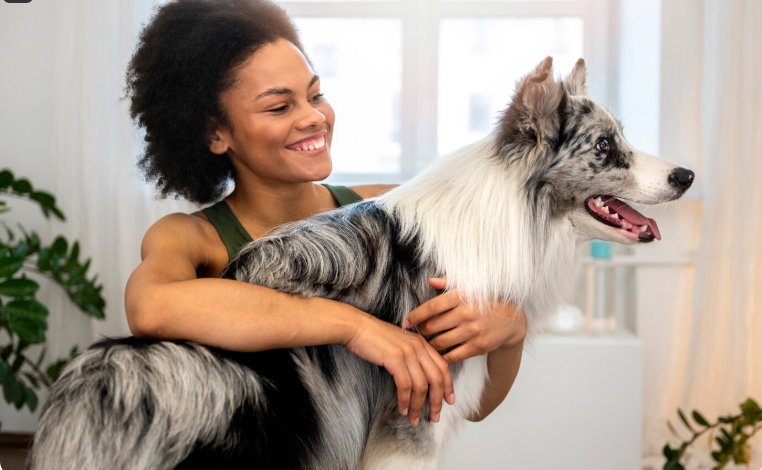
Training your dog is more than just teaching commands; it’s about understanding and addressing behavioral issues that can affect your dog’s well-being and your relationship with them. Here are ten common dog behavior problems and practical solutions to help you and your furry friend live harmoniously.
Table of Contents
Toggle- 1. Excessive Barking
- 2. Jumping on People
- 3. Aggression Towards Other Dogs
- 4. House Soiling
- 5. Chasing Cars or Bikes
1. Excessive Barking
Why It Happens:
Barking is a natural form of communication for dogs. However, when it becomes excessive or inappropriate, it’s usually a sign that something is wrong or unmet in the dog’s environment or routine. Understanding the root cause is the first step toward correcting the behavior.
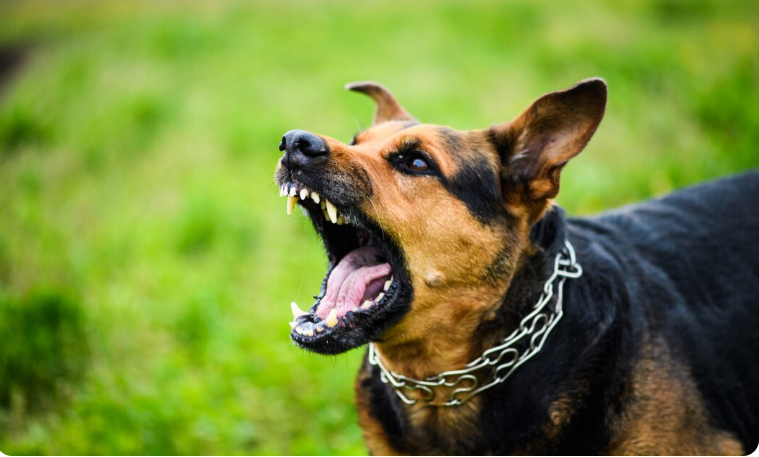
Common Causes of Excessive Barking:
1.1. Boredom and Lack of Stimulation
Dogs, especially active breeds, need physical and mental stimulation. Without toys, interaction, or exercise, they may bark simply to release pent-up energy or to entertain themselves.
1.2. Separation Anxiety
When dogs are left alone for long periods, they may bark due to stress or panic. This type of barking is often high-pitched and continuous and may be accompanied by other symptoms like pacing, chewing, or house soiling.
1.3. Territorial or Protective Instincts
Dogs often bark when someone approaches their home, yard, or owner. This instinct is strong in breeds bred for guarding or herding. It’s their way of alerting and protecting their space.
1.4. Attention-Seeking Behavior
If a dog learns that barking gets attention—positive or negative—they may continue doing it. This includes barking for food, play, or just to get a reaction.
1.5. Fear or Alarm Barking
Dogs may bark in response to sudden noises, unfamiliar objects, or people. This is often a reactive type of barking tied to fear or uncertainty.
1.6. Medical Issues or Discomfort
Pain, cognitive dysfunction (especially in older dogs), or sensory decline (hearing/vision loss) can cause barking. It’s always wise to rule out a medical cause with your vet.
How to Fix Excessive Barking:
2.1. Identify the Trigger
Start by observing when and where the barking occurs. Keep a barking diary for a few days to spot patterns. Is it when you’re gone? When strangers walk by? Understanding the trigger is essential.
2.2. Increase Physical and Mental Exercise
A tired dog is less likely to bark excessively. Increase daily walks, incorporate fetch games, or use puzzle feeders to keep their brain busy.
2.3. Use Desensitization and Counter-Conditioning
If your dog barks at specific triggers (like the mail carrier), gradually expose them to the trigger at a distance and reward calm behaviour. Over time, reduce the distance as they become more comfortable.
2.4. Teach the “Quiet” Command
- Wait for your dog to bark.
- Say “Quiet” in a calm, firm voice.
- Wait for them to stop barking, even if just for a second.
- Immediately reward with a treat and praise.
- Practice consistently.
2.5. Avoid Unintentional Reinforcement
Don’t reward barking by giving in—such as giving a treat to stop barking. Instead, reward when they are calm and quiet.
2.6. Use Positive Reinforcement
Always reinforce good behavior. If your dog stays quiet when someone knocks, give treats and praise. Positive reinforcement is more effective than punishment.
2.7. Manage the Environment
- Block views if your dog barks at passersby through the window.
- Use white noise or calming music if outside noises trigger barking.
- Provide chew toys or frozen Kongs when you leave the house to prevent barking from boredom or separation anxiety.
2.8. Professional Help
If barking persists despite your best efforts, consult a dog trainer or behaviorist. For anxiety-related barking, veterinarians may recommend anxiety medications or calming supplements.
Tools and Products That Help:
- Anti-Bark Collars (Only vibration or citronella recommended; avoid shock collars).
- Window Film to reduce visual stimuli.
- Interactive Toys like treat-dispensing puzzles.
- White Noise Machines or pet-calming playlists.
- Adaptil Diffusers – synthetic pheromone products that can help calm dogs.
2. Jumping on People
Why It Happens:
Jumping is a common but undesirable behavior that dogs use to greet people. It stems primarily from excitement, attention-seeking, or learned behavior. Puppies naturally jump to reach their mother’s face, and this instinct continues into adulthood if not redirected.
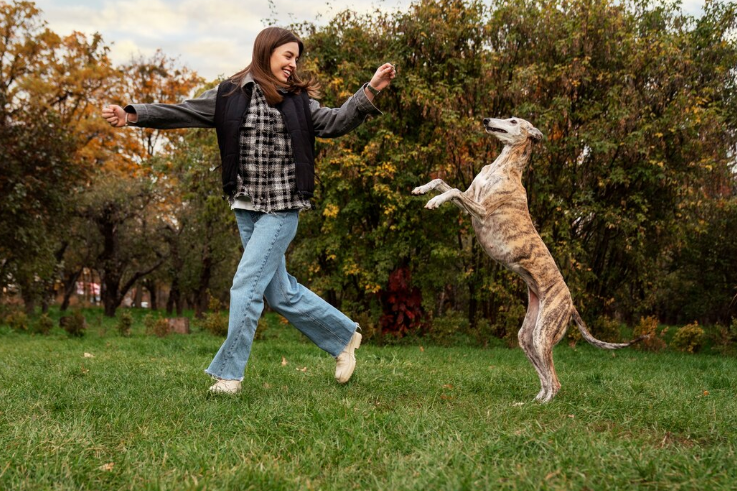
Common Causes of Jumping:
2.1. Excitement or Overstimulation
Dogs often jump when they’re overwhelmed with joy—usually when you return home, during play, or when guests arrive. They can’t contain their enthusiasm, and jumping becomes their outlet.
2.2. Attention-Seeking Behaviour
If jumping has resulted in attention (petting, talking, or even scolding), dogs may repeat it because they associate it with getting noticed.
2.3. Lack of Training or Inconsistent Reinforcement
If a dog is sometimes rewarded for jumping (even unintentionally), it creates confusion. For example, if you allow it at home but discourage it in public, the inconsistency reinforces the behaviour.
2.4. Greeting Instinct
Dogs explore and greet each other face-to-face. They often try to reach our faces to say “hello” the dog way.
Why You Should Correct Jumping:
- Can injure children, elderly people, or guests.
- Reinforces bad manners, especially in public places or during visits.
- Can lead to further behavioural issues, like dominant behaviour or overexcitement.
- Unhygienic if dogs jump with muddy paws.
Effective Solutions to Stop Jumping:
1. Teach an Alternative Behaviour
“Sit to Greet” Method
- Train your dog to sit when someone approaches.
- Only allow people to pet your dog when they are sitting.
- If the dog stands or jumps, the person should withdraw attention immediately.
- Reward with treats and praise only when the dog sits.

2. Ignore the Jumping
Dogs jump to get attention—even scolding counts. Instead:
- Turn your back when the dog jumps.
- Avoid eye contact or verbal interaction.
- Wait until the dog has all four paws on the floor, then calmly acknowledge them.
- Over time, they learn that jumping gets no reward, but calm behaviour does.
3. Use Leash Management During Greetings
- Keep your dog on a short lead when meeting people.
- Step on the leash so they physically cannot jump.
- Once the dog remains calm, allow the greeting.
- Reward calm, seated greetings with treats or gentle petting.
4. Practice Greeting Scenarios
- Set up practice sessions with friends or family.
- Rehearse greeting someone at the door while keeping the dog in a calm sit.
- Use treats to reinforce calm behaviour.
- Gradually increase the challenge by adding excitement (e.g., loud greetings, guests bringing toys).
5. Remove the Reward
- If your dog jumps when you walk in, calmly walk back out and close the door.
- Wait a few seconds and try again.
- Repeat until your dog remains calm upon your return.

6. Training Tools (Optional Use)
- Front-clip harnesses give better control during training.
- Head halters can help redirect energy and jumping.
- Avoid tools like shock collars, which can harm trust and do not teach alternative behaviour.
Puppy-Specific Considerations
- Start early! Puppies can be taught bite inhibition and polite greetings from 8 weeks.
- Reward calm behaviour every single time.
- Avoid rough play that encourages jumping or lunging.
Reinforcing Good Behaviour
- Always reward the behaviour you want to see. Calm greetings should be celebrated.
- Use high-value treats when introducing new people or high-excitement scenarios.
- Maintain calm energy. If you come home squealing and hyping up your dog, you’re encouraging excitement.
Common Mistakes to Avoid



3. Aggression Towards Other Dogs
Why It Happens:
Dog-to-dog aggression is one of the most serious and challenging behavioral issues dog owners face. While it can be alarming, aggression is often rooted in understandable triggers such as fear, poor socialization, or resource guarding. It’s essential to address it promptly and appropriately to prevent harm and restore confidence in both dog and owner.
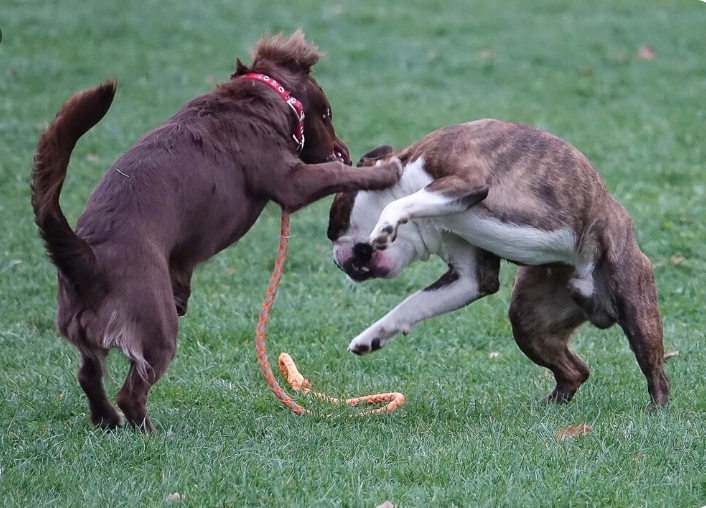
Common Causes of Aggression Toward Other Dogs:
3.1. Fear-Based Aggression
Many dogs lash out aggressively not because they are dominant or “bad,” but because they feel threatened. This is especially true if the dog has had a negative experience with another dog in the past. Fearful dogs may growl, lunge, or snap as a defensive response.
3.2. Lack of Socialization
If a dog wasn’t adequately socialized during the critical period (3–14 weeks of age), they may not know how to interact appropriately with other dogs. This often results in confusion, anxiety, or overreactive behavior when encountering new dogs.
3.3. Territorial or Protective Behavior
Some dogs feel the need to guard their space (home, yard, or owner) and may react aggressively toward unfamiliar dogs approaching their territory.
3.4. Dominance or Resource Guarding
Dogs may become aggressive over possessions like toys, food, or even their owner’s attention. This form of aggression often stems from competition and unclear boundaries.
3.5. Redirected Aggression
A dog that becomes aroused or excited by another stimulus (e.g., a passing jogger) may redirect that frustration toward the closest dog—often one they live with.
3.6. Hormonal Factors
Unneutered male dogs are more likely to show aggression toward other males, especially in the presence of a female in heat. Hormonal changes can heighten territorial instincts or reactivity.
Signs of Inter-Dog Aggression
Recognising early signs can help you intervene before an altercation occurs:
- Growling, snarling, snapping
- Hard staring or body stiffening
- Lunging or pulling on the leash
- Raised hackles (piloerection)
- Barking intensely with a closed mouth
How to Manage and Correct Dog-to-Dog Aggression:
1. Consult a Professional Trainer or Behaviourist
This cannot be overstated. Dog aggression can escalate dangerously without proper intervention. A certified behaviourist or force-free trainer will:
- Assess the root cause of the aggression.
- Develop a tailored desensitization and counter-conditioning plan.
- Ensure safety for both the dog and others during training.
2. Desensitization and Counter-Conditioning
This method slowly changes your dog’s emotional response to other dogs.
Steps:
- Begin by exposing your dog to other dogs at a distance where they can see but not react.
- Pair the sight of another dog with high-value treats (cheese, boiled chicken, etc.).
- Gradually reduce the distance over time, as long as your dog remains calm.
- If they react, increase the distance and slow the pace.
This method teaches your dog to associate other dogs with positive experiences instead of fear or stress.
3. Focus on Obedience and Impulse Control
Solid basic commands like “sit,” “look at me,” “leave it,” and “heel” can help redirect your dog’s attention in tense moments. Training in non-reactive settings builds trust and control.
Impulse control exercises:
- “Wait” before meals or treats.
- “Stay” during door openings or when another dog is nearby.
- “Look at me” for redirecting focus away from distractions.
4. Leash Training and Management
Some dogs are leash-reactive due to feeling restrained. They may bark or lunge simply because they feel trapped.
What helps:
- Avoid tension in the leash—keep it loose but controlled.
- Use tools like front-clip harnesses or head halters for better redirection.
- Do not use choke chains or prong collars, as they increase fear and aggression.
- Cross the road or turn away from other dogs if needed, to avoid confrontations.
5. Avoid Triggers During Training
Until your dog improves:
- Walk during quiet hours.
- Avoid off-leash dog parks.
- Keep greetings to zero or highly controlled interactions with other dogs.
Success depends on controlled setups, not chaotic, unpredictable environments.
6. Spaying/Neutering
If your dog’s aggression is hormone-driven (particularly in intact males), spaying or neutering can sometimes reduce aggression. However, it is not a guaranteed fix and should be considered alongside behavioural training.
Training Tools to Assist (Use Responsibly)
- Head Halters (Gentle Leader or Halti): Give better control of your dog’s head and direction.
- Front-clip harnesses: Prevent pulling and reduce arousal on leash.
- Muzzles: Useful for training or public exposure if aggression is severe. Muzzles should always be introduced positively and not as punishment.
What Not to Do:



Certainly! Here’s a comprehensive expansion on House Soiling in Dogs—covering causes, types, solutions, and tips for prevention in a search-engine-optimized and reader-friendly format:
4. House Soiling
Why It Happens:
House soiling, or inappropriate elimination, is one of the most common and frustrating behavioural issues for dog owners. When a dog urinates or defecates indoors, it’s often the result of incomplete house training, changes in routine, anxiety, or underlying medical conditions. Addressing this problem requires a clear understanding of the cause, consistent training, and sometimes veterinary support.
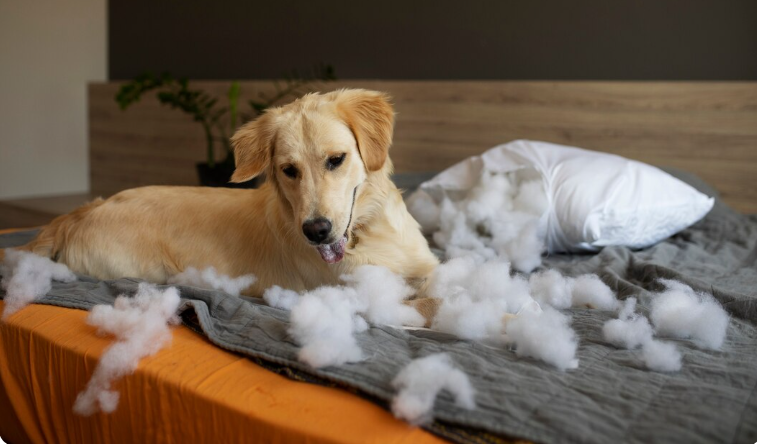
Common Causes of House Soiling in Dogs
1. Incomplete or Inconsistent House Training
Many dogs never receive consistent or thorough training during their early development. Without a predictable routine or clear expectations, dogs may not learn the appropriate place to eliminate.
2. Medical Issues
Various health problems can contribute to house soiling, including:
- Urinary tract infections (UTIs)
- Kidney disease
- Gastrointestinal disorders
- Diabetes
- Incontinence (especially in senior dogs)
It’s critical to consult a veterinarian if your house-trained dog suddenly starts having accidents.
3. Anxiety or Stress
Stress from a change in environment, schedule, or household (like a new baby or moving home) can trigger inappropriate elimination. Separation anxiety, in particular, may lead to soiling when the dog is left alone.
4. Territorial Marking
Primarily seen in unneutered males but also in females, dogs may urinate indoors to mark their territory, especially when new animals or people are introduced into the home.
5. Age-Related Factors
Puppies lack bladder control early on, and senior dogs may suffer from cognitive dysfunction or age-related incontinence. Both ends of the age spectrum require special considerations.
6. Excitement or Submissive Urination
Some dogs urinate when overly excited or when feeling submissive. This is especially common in puppies or shy dogs and typically occurs during greetings or scolding.
Solutions for House Soiling
1. Establish a Consistent Bathroom Schedule
Create a reliable daily routine for potty breaks. Dogs, especially puppies, thrive on consistency and structure.
Typical times to take your dog out:
- First thing in the morning
- After eating or drinking
- After play or exercise
- Before bedtime
- Every 1–2 hours for puppies or newly adopted dogs
Reinforce the idea that outside is the correct place to eliminate.
2. Supervise and Confine
Closely monitor your dog indoors until house training is solid. Use crates, playpens, or baby gates to confine the dog to areas where they can be supervised.
Crate training, when used correctly, helps dogs develop bladder control and a preference for eliminating outdoors.
Note: A crate should be large enough for the dog to stand, turn, and lie down—but not so big that they can eliminate in one corner and rest in another.
3. Reward-Based Training
Always reward outdoor elimination immediately and generously. Use high-value treats and praise to reinforce the behavior. The faster and more consistently you reward outdoor potty habits, the more quickly your dog will learn.
Avoid punishment for accidents indoors—it only creates fear and confusion, especially if the dog does not understand the timing.
4. Clean Accidents Thoroughly
Use an enzymatic cleaner specifically designed for pet messes to remove all traces of odour. Standard household cleaners may not eliminate the scent, encouraging the dog to return to the same spot.
5. Rule Out Medical Issues
If your dog suddenly begins house soiling after being reliably trained, schedule a veterinary check-up. Conditions like bladder infections, kidney disease, or gastrointestinal problems can make it difficult for dogs to control elimination.
For dogs experiencing stress-induced accidents:
- Stick to a calm, predictable routine.
- Use calming aids (e.g., pheromone diffusers).
- Work on building independence if separation anxiety is the cause.
- Avoid creating high-pressure greetings or scoldings that trigger submissive urination.
7. Spay/Neuter to Prevent Marking
If the issue is territorial marking, neutering or spaying your dog can significantly reduce the behavior—particularly in young males. Marking may still require behavioral intervention, especially if it has become a habit.
House Soiling in Puppies vs. Adult Dogs
Puppies require much more frequent potty breaks and positive reinforcement. Expect accidents early on, and stay patient. Never punish a puppy for house soiling—redirect them calmly and reward outdoor success.
Adult dogs that were never properly trained or are rescued from shelter environments may also need a restart in house training. Treat them like a puppy—tight supervision, frequent outings, and positive reinforcement.
Special Considerations for Senior Dogs
Older dogs may struggle with:
- Weak bladder control
- Joint pain making it difficult to reach the door
- Canine cognitive dysfunction (similar to dementia)
In such cases:
- Increase the number of potty breaks.
- Keep sleeping areas close to outdoor access.
- Consider doggy diapers or indoor potty pads as a last resort.
How to React When an Accident Happens
If you catch your dog in the act:
- Interrupt calmly: say “Ah-ah!” or clap.
- Immediately take them outside to finish.
- Praise and reward if they complete elimination outside.
If you find it after the fact:
- Clean it thoroughly.
- Do not punish—your dog will not associate the punishment with the accident.
Tips to Prevent Future Accidents
- Set reminders or alarms for regular potty breaks.
- Keep a journal tracking feeding and elimination to identify patterns.
- Feed your dog at the same times each day.
- Gradually increase freedom in the house as the dog proves reliability.
When to Get Help
If you’ve implemented consistent training and ruled out medical causes but your dog continues to soil indoors, it may be time to:
- Work with a certified dog trainer or behaviorist.
- Perform additional diagnostic tests with your veterinarian.
- Explore anxiety treatments or management strategies for dogs with separation or noise anxieties.
5. Chasing Cars or Bikes
Why It Happens:
Chasing moving objects, such as cars, bicycles, or joggers, is a deeply rooted instinct in many dogs. This behavior stems from their natural prey drive—a survival mechanism inherited from their wild ancestors. When something fast-moving passes by, it can trigger an automatic response to chase, regardless of obedience training or breed. While common, this behavior is dangerous and must be addressed early.

Understanding the Prey Drive in Dogs
Dogs with high prey drives (like herding or hunting breeds such as Border Collies, German Shepherds, Terriers, or Huskies) are more likely to exhibit chasing behavior. This instinct may be harmless in a game of fetch but becomes hazardous when directed toward traffic or pedestrians.
Key traits of prey drive include:
- Focused staring
- Stalking or crouching
- Sudden sprinting or lunging
- Ignoring recall commands in the moment
This isn’t disobedience—it’s an instinctual override of training that can lead to accidents, injuries, or even legal trouble if someone is harmed.
Risks Associated with Chasing Behavior
- Traffic danger: Dogs that chase cars risk being hit or causing an accident.
- Injury to others: Cyclists or runners may be startled, lose balance, or fall.
- Legal liability: In many regions, owners are held responsible if their dog causes harm or property damage.
- Reinforced behavior: When a dog chases and the object disappears (car drives off), they feel rewarded and are more likely to repeat the behavior.
Early Signs of Problem Behavior
Recognizing early indicators helps prevent escalation:
- Lunging at cars during walks
- Fixating on movement
- Barking or whining at passing vehicles
- Darting off when off-leash
Effective Solutions: How to Stop a Dog from Chasing Cars or Bikes
1. Train Impulse Control
The foundation of stopping chasing behavior is impulse control. Your dog must learn to resist the urge to lunge at stimuli.
Key commands to teach:
- “Leave it”: Teaches your dog to disengage from a distraction.
- “Watch me”: Focus attention on you rather than the stimulus.
- “Stay” or “Sit-Stay”: Encourages calmness in the presence of triggers.
Training tips:
- Start in low-distraction areas.
- Use high-value treats or toys as rewards.
- Practice frequently with increasing difficulty.
2. Use Desensitization and Counter-Conditioning
These techniques gradually change your dog’s emotional response to moving objects.
- Desensitization: Expose your dog to the stimulus (e.g., a slow-moving bicycle) at a safe distance where they remain calm.
- Counter-conditioning: Pair the sight of the stimulus with something positive (treats, praise) to create a new, pleasant association.
Over time, your dog will learn that bikes or cars mean good things happen—not a call to chase.
3. Manage the Environment
Until your dog is reliable, avoid situations where chasing could happen:
- Always leash your dog in unfenced areas.
- Use a front-clip harness or head halter to reduce pulling and give you more control.
- Avoid walking in high-traffic zones if your dog is reactive.
At home, secure your yard with a tall, escape-proof fence, and supervise outdoor time to prevent self-rewarding behavior.
4. Redirect the Behavior
Instead of allowing your dog to rehearse bad habits, redirect their energy to more acceptable outlets.
- Play fetch or tug to satisfy their chase instinct.
- Teach your dog to target (touch your hand with their nose), then use it to redirect when they fixate on a trigger.
- Use toys or a ball to capture attention during walks if a bike or jogger appears.
5. Mental and Physical Enrichment
Bored dogs are more likely to misbehave. Meet your dog’s needs to reduce reactivity:
- Daily walks and play sessions that provide variety and stimulation.
- Interactive toys like puzzle feeders or scent games.
- Obedience and trick training to challenge their brain.
A well-exercised dog is less likely to feel the need to chase.
6. Work with a Professional Trainer
If your dog’s chasing behavior is intense or escalating, it’s wise to consult a certified positive-reinforcement trainer or behaviorist. They can:
- Evaluate your dog’s specific triggers
- Design a desensitization program
- Provide hands-on guidance to build reliability
This is especially important for high-prey-drive dogs, newly adopted rescues, or any dog that has previously caused harm.
Some breeds are genetically predisposed to chase:
- Herding dogs may chase moving objects in an attempt to control or herd them.
- Sighthounds (like Greyhounds and Whippets) are hardwired to pursue visual stimuli.
With these dogs, management and structured exercise become even more critical.
Tips to Reinforce Calm Behavior
- Reward calm, non-reactive responses with treats or praise.
- Use the “sit” or “look at me” command every time a car or bike passes.
- Practice walking in areas with controlled distractions before progressing to busier environments.
What to Avoid
- Do not punish your dog for chasing behavior—it may increase anxiety or excitement.
- Never allow off-leash access in unfenced areas if your dog isn’t 100% recall reliable.
- Don’t chase your dog if they run—this can turn it into a game.
Conclusion
Chasing cars or bikes might seem like a minor issue, but it can quickly become dangerous. Recognizing the instinct behind the behavior and using structured, reward-based training is key to resolving it. By teaching impulse control, managing the environment, and providing appropriate outlets for energy, you can help your dog stay safe, focused, and calm in the presence of moving objects.
With consistency and patience, even the most enthusiastic chaser can learn to walk calmly by your side—regardless of what rolls past.